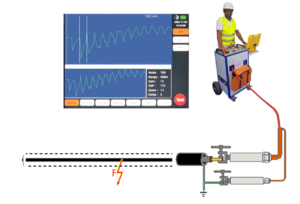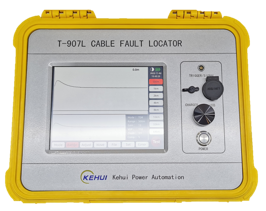T-907L Power Cable Fault Locator

Fault Pre-location
A power cable fault is unlikely to exhibit a sufficiently low resistance to allow a Time Domain Reflectometry (TDR) pulse to be reflected and it is usually necessary to modify the fault to create a situation where the it is suitable for pre-location techniques to be applied. This is carried out using a surge generator to inject energy in to the cable. This energy converts the fault such that the fault becomes low-resistance, allowing the use of TDR to measure the distance to the fault.

The TDR injects impulse on to cable and compares the reflection from the cable before and during the arcing. The deviation of the signals (D) represents the distance to the fault position based on time and a known pulse propagation velocity. This technique allows the approximate position of the fault to be determined. The exact location will then be identified through pinpointing.
T-907L
The T-907L is an easy to use, portable fault locator for low, medium and high-voltage power cables. It can be applied for the pre-location of all kinds of faults, including open circuit, short circuit, low resistance, high-resistance and flashovers.
The T-907L can operate in four modes: Time Domain Reflectometry (TDR), Secondary/Multiple Impulse Method, (SIM/MIM), Decay Method and Impulse Current Method (ICM). Most power cable faults exhibit a high resistance, which requires the application of a high voltage surge to break it down for the purpose of pre-location and so the T-907L is especially effective when used in conjunction with a surge generator such as the T-305E or T-305-16.
Of the four modes mentioned, ICM is the most cost-effective method of measuring the distance to the fault. In the T-907L, the ICM is augmented by an Automatic Impulse Current (AIC) method, in which waveform recognition techniques are applied to calculate the fault location automatically, without the need for the operator to manually interpret the waveforms. This method uses an external current coupler which is compatible with most types of surge generator.
Alternatively, the SIM/MIM method can be used, where the TDR signal is coordinated with the energy surge from the T-305E through a dedicated interface.
For flashover faults requiring a high breakdown voltage, the Decay Method can be applied in conjunction with a HV DC source. The cable is charged by the DC source until it breaks down, creating a transient voltage signal which is captured through a capacitive voltage divider and used for fault location analysis.

T-907L technical data
| Measuring range | 64km |
| Fault location methods | TDR, ICM, SIM/MIM and Decay |
| Voltage of transmitting pulse | 30V |
| Width of transmitting pulse | 40 ns -7 μs |
| Voltage withstand | 400V AC (50/60Hz) |
| Output impedance | 5-87 Ohm |
| Sampling rate | 400MHz (2.5ns) |
| Display | 8 inch, TFT, Touch screen and Colour LCD |
| Charger | Input: 110V – 240V AC; Output 8.4V DC, Current 3A |
| Weight | 4.5kg |
| Dimensions | 330 x 305 x 152mm |
| Operating temperature | -10o to +50oC |
| Ingress protection | IP54: Splash proof and dust protected (when closed) |
| Storage temperature | -20 to +50°C |

